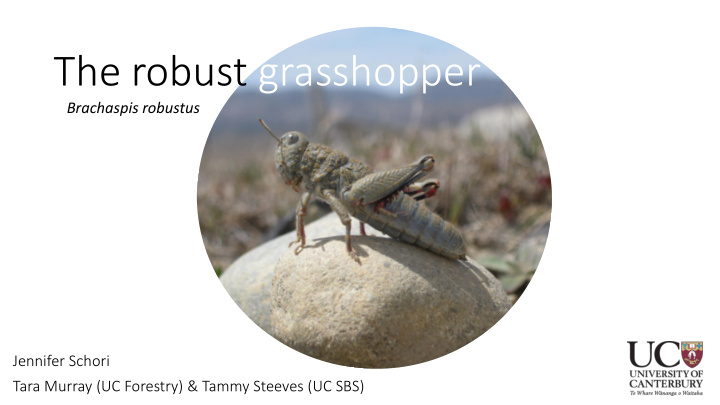



The robust grasshopper Brachaspis robustus Jennifer Schori Tara Murray (UC Forestry) & Tammy Steeves (UC SBS)
Conservation translocation “ The intentional movement and release of a living organism where the primary objective is a conservation benefit ” – IUCN 2013 Achieving a conservation benefit • Optimise founder populations • Remove driver of population decline
Conservation translocation “ The intentional movement and release of a living organism where the primary objective is a conservation benefit ” – IUCN 2013 Achieving a conservation benefit • Optimise founder populations • Remove driver of population decline
Optimise founder populations • Reproductively viable individuals • Minimal loss of reproductive individuals • Populations which can maintain genetic diversity over time
Reproduction and development • Polygamous mating system Males and females mate with multiple individuals of the opposite sex • Females lay 1 – 2 egg batches in a season (probably more) • Egg batches contain between 17 and 35 eggs
Proposed life cycle
Conservation translocation “ The intentional movement and release of a living organism where the primary objective is a conservation benefit ” – IUCN 2013 Achieving a conservation benefit • Optimise founder populations • Remove driver of population decline
Could it be predatory mammals?
Nocturnal behaviour Nocturnal behaviour of adult females is highly vulnerable to predation by nocturnal mammals
Evidence from other Mackenzie grasshoppers?
Predator control No predator control 200 Tekapo 200 Upper Ohau 150 Max count p = 0.16 150 100 Max count 100 p = 0.06 50 200 50 Lower Ohau 0 0 150 2007 2009 2011 2013 2015 2017 2007 2009 2011 2013 2015 2017 Max count 100 Counted 14 more individuals on 50 p = 0.34 average each year 0 2007 2009 2011 2013 2015 2017
Experimental translocation
Translocated robust grasshoppers PRA 100 = P redator R educed A rea 90 Non PRA 80 70 = Non P redator R educed A rea Population Size 60 50 Observed: PRA 40 Observed: Non PRA 30 20 10 0 Feb Feb Feb Mar Mar Apr Sep Oct Oct Nov Nov Dec Dec Jan Jan Jan Feb Recapture Occasion
Translocated robust grasshoppers PRA 100 = P redator R educed A rea 90 Non PRA 80 70 = Non P redator R educed A rea Population Size 60 50 Observed: PRA 40 Observed: Non PRA Estimated: PRA 30 Estimated: Non PRA 20 10 0 Feb Feb Feb Mar Mar Apr Sep Oct Oct Nov Nov Dec Dec Jan Jan Jan Feb Recapture Occasion
https://www.jonesfish.com/ Minnow trapping: Only caught 2 lizards!
https://www.jonesfish.com/ Minnow trapping: Only caught 2 lizards! Visual searches: 6 vs. 18 In PRA In Non PRA
Tracking tunnels: Fewer hedgehogs in PRA (p=<0.001, df=) https://www.jonesfish.com/ http://sciencelearn.org.nz/ Minnow trapping: Only caught 2 lizards! 90 PRA * 80 Non PRA 70 Tracking rate 60 50 Visual searches: 40 30 20 6 vs. 18 10 In PRA In Non PRA 0 Cat Hedgehog Mouse Mustelid Skink Gecko
Linking decline to mammalian predation • Mammalian predators in both areas Only hedgehogs present in significantly lower abundance • More predators than just mammals Birds, skinks, predatory invertebrates • Multiple pressures during translocation Stress, dispersal, starvation • Very difficult to determine cause of death Continuous moulting, highly cryptic
Linking decline to mammalian predation • Mammalian predators in both areas Only hedgehogs present in significantly lower abundance • More predators than just mammals Birds, skinks, predatory invertebrates • Multiple pressures during translocation Stress, dispersal, starvation • Very difficult to determine cause of death Continuous moulting, highly cryptic Conclusion: Moderate predator control not sufficient
Acknowledgements Many thanks to: Tara Murray, Tammy Steeves, Carol Burke, Richard Maloney and DOC Twizel staff Department of Conservation Environment Canterbury Forest and Bird, JS Watson Trust, Stocker Scholarship NZFGW Canterbury Branch, Sadie Balkind Award University of Canterbury, Doctoral Scholarship And everyone else who has helped along the way!
Recommend
More recommend